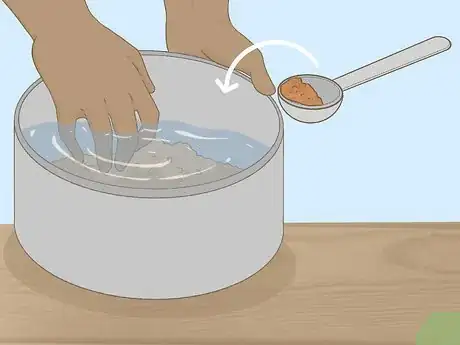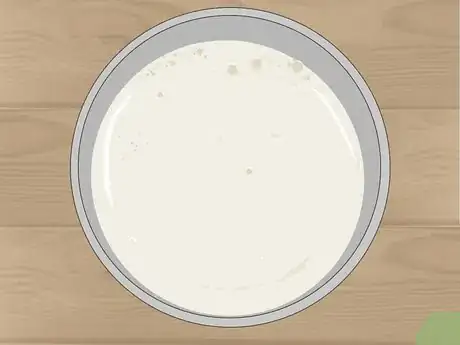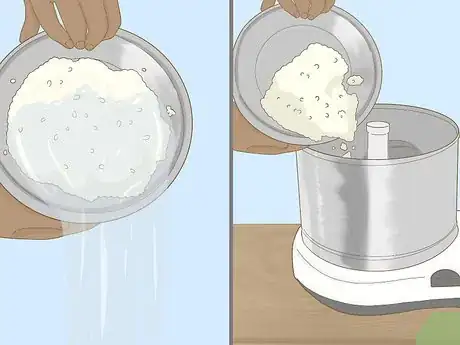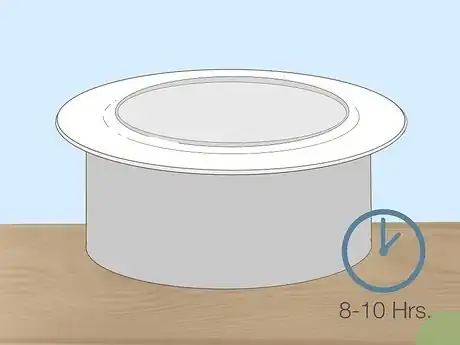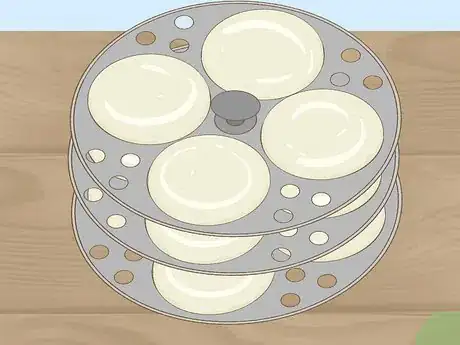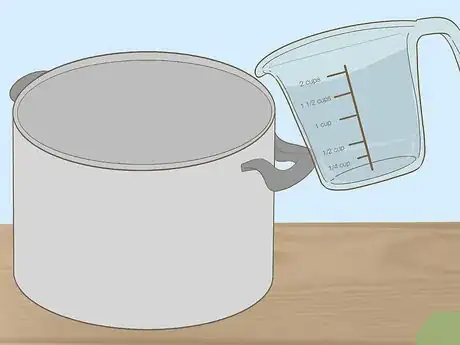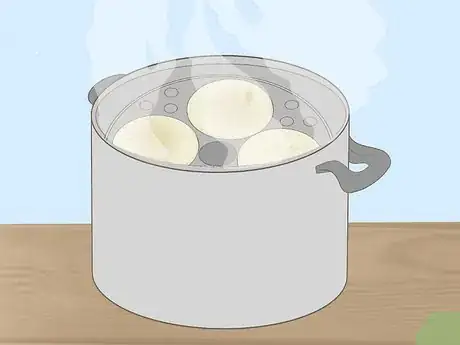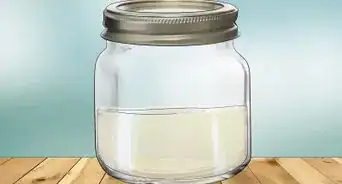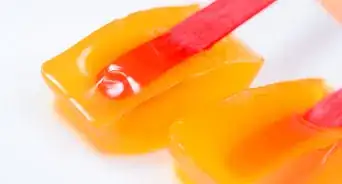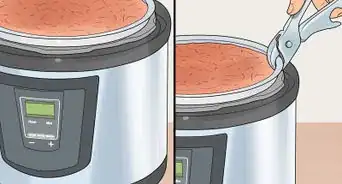This article was co-authored by wikiHow Staff. Our trained team of editors and researchers validate articles for accuracy and comprehensiveness. wikiHow's Content Management Team carefully monitors the work from our editorial staff to ensure that each article is backed by trusted research and meets our high quality standards.
This article has been viewed 71,016 times.
Learn more...
Idli are a type of rice cake served for breakfast with sambar and chutney. They are especially popular in many south Indian countries. The most popular way of making them is with a steamer, but you can use a pressure cooker as well. The process takes a while, because the ingredients need to soak and ferment, but the results are well worth it, not to mention delicious!
Ingredients
- ½ cup (100 g) of whole or split urud dal (black gram)
- ½ tablespoon of fenugreek seeds
- ¼ cup (37g ) of poha (flattened rice)
- 1 cup (225 g) of parboiled rice (idli-dosa or short-grain)
- 1 cup (225 g) of bastami rice
- Water, for soaking
- Salt, to taste
- Oil, for greasing the pans
Serves 4
Steps
Rinsing and Soaking the Ingredients
-
1Rinse the urud dal and fenugreek seeds until the water runs clear. Place ½ cup (100 g) of urud dal (black gram) and ½ tablespoon of fenugreek seeds into a pot. Fill the pot with water, then use your hand to swish the urud dal and seeds around. Drain the water from the pot, then repeat the process 1 to 2 more times.[1]
- You can use whole or split urud dal.
- Alternatively, place the urud dal and fenugreek seeds into a strainer, then hold them under running water. Sift them until the water runs clear.
-
2Soak the urud dal, seeds, and poha in water for 4 to 5 hours. Drain the urud dal and fenugreek seeds 1 last time. Keep them in the pot, then add ¼ cup (37g ) of poha and 1 cup (240 mL) of water. Set the pot aside for 4 to 5 hours.[2]
- Poha is also called “flattened rice.”
- The urud dal, fenugreek seeds, and poha will expand as they soak, so make sure the pot is big enough to hold twice the amount.
- Get started on rinsing the rice while the urud dal, seeds, and poha are soaking. This way, they will both be ready at the same time.
Advertisement -
3Rinse the parboiled rice and basmati rice until the water runs clear. Place 1 cup (225 g) of parboiled rice and 1 cup (225 g) of bastami rice into a pot. Fill the pot with water, then swish the rice around. Drain the water, then repeat the process 2 to 3 more times.[3]
- For the parboiled rice, use either idli-dosa or short-grain rice.
- Use a separate pot for this. Do not use the same pot that the urud dal, fenugreek seeds, and poha are soaking in.
- You could also rinse the rice in a strainer under running water. Sift the rice with your fingers until the water runs clear.
-
4Soak the rice in 2 cups (470 mL) of water for 4 to 5 hours. Drain the last of the water from the rice, then pour in 2 cups (470 mL) of water. Set the pot aside for 4 to 5 hours so that the rice can soak as well.[4]
Mixing the Batter
-
1Drain the urud dal mixture and transfer it into a grinder. Set a strainer over a bowl or pitcher, then pour the urud dal mixture through it. Save the drained water, and transfer the urud dal mixture into a grinder.[5]
- You can also use a mixer, blender, or food processor for this.
-
2Grind the urud dal while gradually adding the water until it is smooth. Pour 1⁄2 cup (120 mL) of the drained urud dal water into the grinder. Pulse the grinder for a few seconds, then add another 1⁄2 cup (120 mL) of drained urud dal water. Keep grinding and adding water until the mixture is smooth and fluffy.[6]
- You probably won’t end up using all of the drained water, which is fine.
- How much water you end up using will vary a little each time. Plan on using about 1 1⁄2 cups (350 mL) of water for every ½ cup (100 g) of urud dal.
-
3Transfer the blended mixture into a large container. The container needs to be deep enough to hold the rice as well. You also need to leave enough room for the final batter to expand. A large cooking pot should work just fine for this.[7]
-
4Drain the water from rice, then add the rice to the grinder. Use the same process as you did for the urud dal mixture. Set the strainer over a pitcher, then pour the rice through it. Put the rice into the grinder and save the rice water.
- You don’t need to clean out the grinder, but you can if you want to. Everything will get mixed together in the end anyway.
-
5Blend the rice with 1⁄2 cup (120 mL) of water until it is coarse and gritty. Pour some of your reserved water into the grinder. Close the grinder and pulse it for a few seconds. Add a little bit more water and pulse it again. Keep going until the rice resembles a coarse batter.[8]
- Use up to 1⁄2 cup (120 mL) of water. Unlike the urud dal mixture, the rice mixture needs to be coarse.
-
6Stir the rice mixture into the urud dal mixture, along with some salt. Pour the blended rice into the blended urud dal. Season it with some rice, then stir everything together until the color and texture are consistent.[9]
-
7Cover the pot with a lid and leave it in a warm place for 8 to 10 hours. A warm kitchen would be ideal. If your home is below room temperature, stick the pot into an oven, then turn the oven light on. Leave the batter covered and undisturbed for 8 to 10 hours while it ferments.[10]
- If your pot or container doesn’t have a lid, use a large plate instead. Cover the pot or container with a blanket, if needed, to ensure that no air gets in.
- If you’re using an oven, don’t actually turn the oven on. The light will generate just enough heat for the batter to ferment.
-
8Stir the fermented batter, then add some salt or baking soda, if needed. After 8 to 10 hours have passed, open up the pot and give the batter a stir. The batter should look bubbly. If it isn’t, stir in a pinch of baking soda. This will help make it bubbly again, which is key to creating perfect idli.[11]
- At this point, you can add some salt if you don’t think the batter is salty enough.
Steaming the Idli
-
1Pour the batter into greased idli pans. Coat the wells of an idli pan with some oil, then use a ladle to pour the batter into it. Don’t fill the wells all the way up to the rim; leave just a small amount of space.[12]
- Repeat the process for all of the idli pans in the set.
- You must use a special idli pan for this. It’s shaped like a metal disk with 3 to 4 round wells in it.
-
2Slide the pans onto the stand, offsetting the wells. Your set of idli pans should have come with a metal stand or plunger that allows you to set it into a pressure cooker. Slide the idli pans onto the stand, making sure to offset the wells so that they aren’t directly above one another. This will allow the idli to expand.[13]
- If you stand the pans with the wells positioned directly above one another, the idli won’t have room to expand as they cook. They will get squashed!
-
3Bring 1 inch (2.5 cm) of water to a boil in a pressure cooker. Fill your pressure cooker with 1 to 2 glasses of water, or however much you need to fill it up by 1 inch (2.5 cm). Bring the water to a boil over medium heat. This may take 3 to 4 minutes.[14]
-
4Set the idli pan into the cooker, cover it with a lid, and open the vent. Make sure that you’re placing the idli pan directly into the water. The pan should have little feet at the bottom, so the idli won’t get wet. Close the lid on your pressure cooker tightly, but leave the vent open.[15]
- In some pressure cookers, you actually have to take the entire vent out.
-
5Allow the idli to cook for 10 to 15 minutes, then remove the idli. The idli are ready when you stick a toothpick into the center and it comes out clean. They should be light, puffy, and fluffy. Use the handle of the stand to lift the pans out of the cooker. Set the entire contraption onto a heat-safe surface.[16]
- Be careful when opening the pressure cooker. Even though you left the vent open, there may still be lots of hot steam coming out.
-
6Let the idli cool for 5 minutes before removing and serving them. Use a wet spoon to scoop the idli out of the molds and transfer them to a plate. Serve them for breakfast with sambar and chutney.[17]
- Coconut chutney pairs especially well with idli. They also taste delicious with rasam and peanut chutney.[18]
Things You'll Need
- 2 mixing bowls
- Large pot or container
- Lid or plate
- Pressure cooker
- Idli pans and stand
- Ladle
- Blender or grinder
References
- ↑ http://foodviva.com/south-indian-recipes/idli-recipe/
- ↑ http://foodviva.com/south-indian-recipes/idli-recipe/
- ↑ http://foodviva.com/south-indian-recipes/idli-recipe/
- ↑ http://foodviva.com/south-indian-recipes/idli-recipe/
- ↑ http://foodviva.com/south-indian-recipes/idli-recipe/
- ↑ http://foodviva.com/south-indian-recipes/idli-recipe/
- ↑ http://foodviva.com/south-indian-recipes/idli-recipe/
- ↑ http://foodviva.com/south-indian-recipes/idli-recipe/
- ↑ http://foodviva.com/south-indian-recipes/idli-recipe/
- ↑ http://foodviva.com/south-indian-recipes/idli-recipe/
- ↑ http://foodviva.com/south-indian-recipes/idli-recipe/
- ↑ http://showmethecurry.com/odds-ends/how-to-make-idli-a-south-indian-treat.html
- ↑ http://showmethecurry.com/odds-ends/how-to-make-idli-a-south-indian-treat.html
- ↑ http://showmethecurry.com/odds-ends/how-to-make-idli-a-south-indian-treat.html
- ↑ http://showmethecurry.com/odds-ends/how-to-make-idli-a-south-indian-treat.html
- ↑ http://foodviva.com/south-indian-recipes/idli-recipe/
- ↑ http://showmethecurry.com/odds-ends/how-to-make-idli-a-south-indian-treat.html
- ↑ https://www.youtube.com/watch?v=IYD4dZn0r4A
- ↑ https://www.seriouseats.com/2013/09/beyond-curry-idlis-steamed-lentil-rice-cake-indian-recipe.html
- ↑ https://lakshmiammal.wordpress.com/tag/idly-rice/
- ↑ https://lakshmiammal.wordpress.com/tag/idly-rice/
